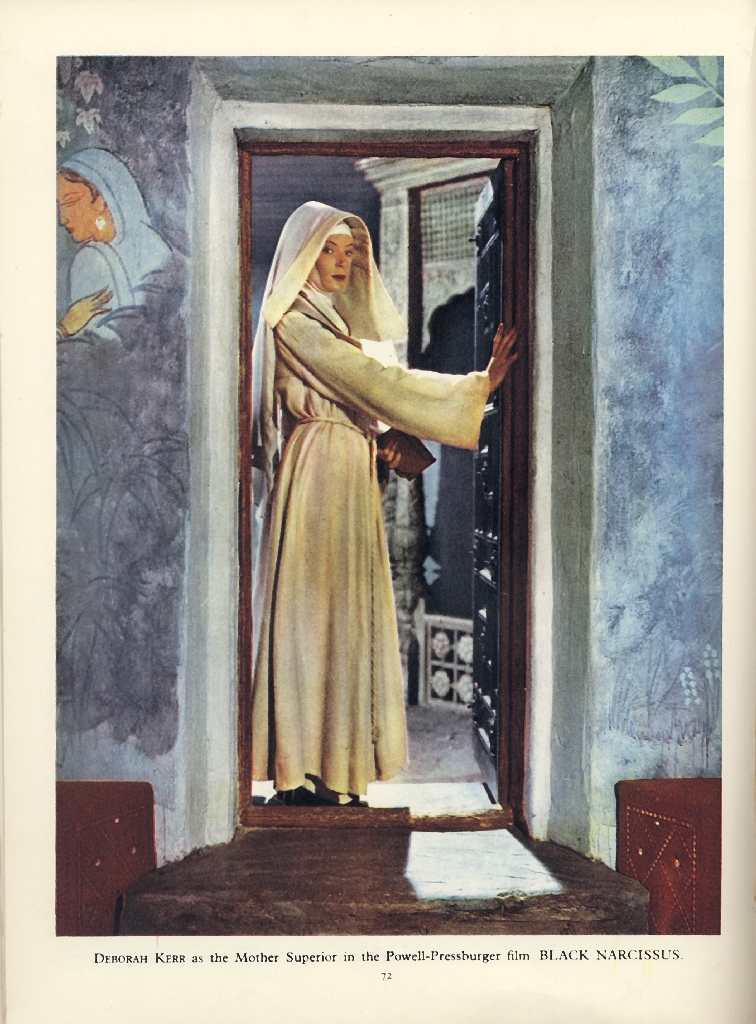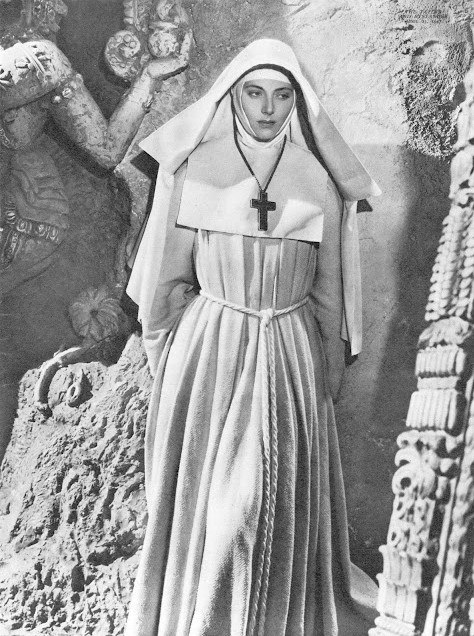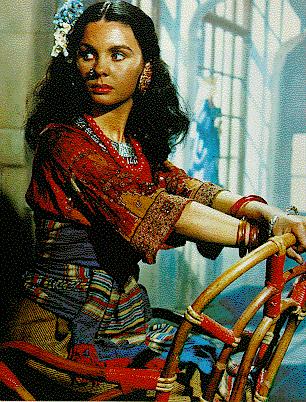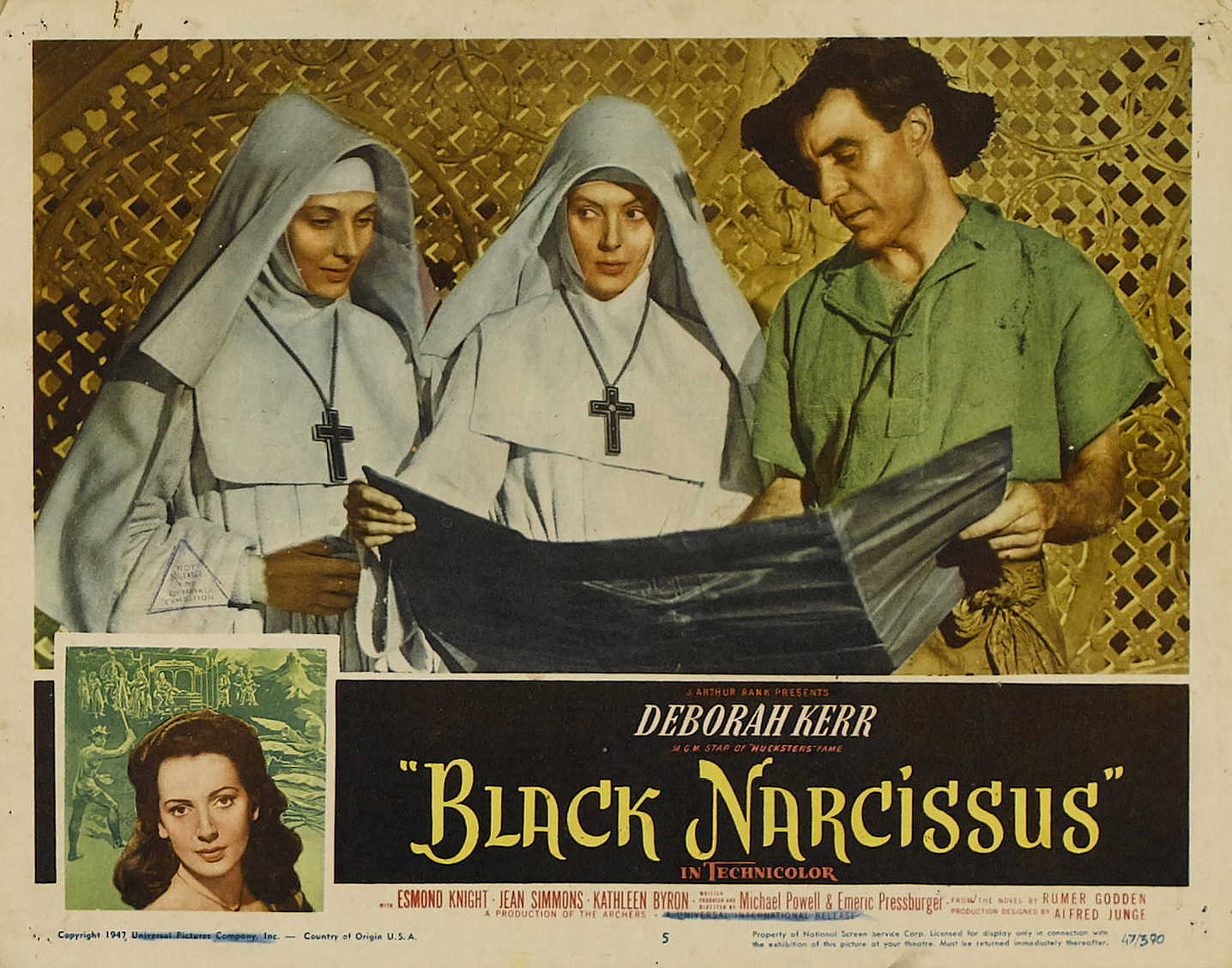In a Himalayan-like atmosphere a group of Nuns are sent to
try and modernize the natives of Mopu. It becomes very clear from the start that it
would be extremely difficult to educate and care for the natives that the film
becomes about a test of patience for the nuns and their struggle to resist
temptation into sexual premise that they explicitly swore not to conceive.
Sister Clodagh (figure 2.) and Sister Ruth (figure 3.) are the two of the main
characters in Black Narcissus and early on warnings are given to Clodagh about
Ruth and how she could cause some issues. A strong use of tone and build up is
used throughout the film but in such a subtle way that is only truly visible
when you revisit the film. At the start, pale and washed out colours inhibit
the environment and even on the characters themselves. But towards the end,
vibrant reds to denounce the erotic build-up of this frustrated film are shown
everywhere; even onto Ruth’s eyeliner. As Micheal Mirasol puts it, “It's
holiness against the libido, civility against the wild, control vs. desire.” (Mirasol,
2010)
 |
| figure 2. Sister Clodagh |
 |
| figure 3. Sister Ruth |
Whilst Black Narcissus may start to seem surreal the further
onwards the film plays, it’s in the utter realistic reactions of the Nuns that
the film shows its prevalence. It uses
heavy imagery such as birds in a cage, or the almost overjoyed expression on
Sister Ruth’s conniving face as she rings the reoccurring bell tower. Infact
even the temple is designed to be as reminiscent of once sexual occurrences and
is not shy about showing it. The constantly ever-growing “Lurid emotions are
matched onscreen by aesthetic and textual excess, effectively amplifying the
darkness and instability evoked by the nuns.” (Bagatavicius, 2012) show just
how mise-en-scene in an environmental sense has been considered to the fullest
as everything works in harmony or completely against eachother at just the
right moments. The Old General’s temple is extremely open and airy yet Michael
Powell and Emeric Pressburger still manage to create a sense of claustrophobia
due to how high up it is and the overall tone of the film. There is a great
comparison between open and repressed intentions.
 |
| figure 4. Sister Ruth's room |
 |
| figure 5. Kanchi |
Another strange thing, possibly because of the time of
making, was the use of Indian actors. The Young General was the only ethnic
Indian and the rest were white actors in makeup. For example, Kanchi (figure 5), played by
Jean Simmons creates this odd illusion and as she does not speak much it only
deepens this. Ironically, this is the only role Jean Simmons is not popularly
known for..
Black Narcissus was ahead of its time in the sense that it
dared to try and deviate from the normal assumption that all women were
practically nuns. – Generally. You can
view the film as a “one off” event where desperate nuns try to contain all of
their urges and ultimately fail; but there is an extreme amount of held back
emotion and outburst that arguably would be present in modern-day films.
Compared to films of today it’s almost boasted that there will be heavily lusty
and sexually orientated scenes throughout, and seemingly unrelated genres of
film contain it; such as Transformers (2007) with Megan Fox. Black Narcissus
may have been one of the very first films to timidly – yet with frustration
laced over the top –show women as epitomes of two extremes, abstinence or total
obsessiveness. “becoming mirror images; extremes of human nature.” (Mirasol,
2010) As Mirasol says, it is Clodagh and Ruth who show these two sides and
throughout Black Narcissus they clash constantly. It could also be the link in
a very long chain as to why in the 70’s TV became so horribly open about absolutely everything when it came to women.
 |
| figure 5. A Farewell between Sister Clodagh and Mr. Dean.. |
-----
Illustration List:
Pressburger, E. (1947). Kanchi. [image] Available at: http://www.powell-pressburger.org/Images/47_BN/Kanchi1.jpg [Accessed 19 Nov. 2014].Pressburger, E. (1947). Sister Clodagh. [image] Available at: http://www.powell-pressburger.org/Images/47_BN/BN-Deborah.jpg [Accessed 19 Nov. 2014].
Pressburger, E. (1947). Sister Ruth. [image] Available at: http://www.powell-pressburger.org/Images/47_BN/NaughtyNun.jpg [Accessed 19 Nov. 2014].
Pressburger, E. (1947). Film Still. [image] Available at: http://puu.sh/cWydO/522690c573.png [Accessed 19 Nov. 2014].
Pressburger, E. (1947). Film Still 2. [image] Available at: http://puu.sh/cWyl1/77a088c791.png [Accessed 19 Nov. 2014].
Pressburger, E. (1947). Movie Poster. [image] Available at: http://www.doctormacro.com/Images/Posters/B/Poster%20-%20Black%20Narcissus_05.jpg [Accessed 19 Nov. 2014].
Bibliography:
Bagatavicius, A. (2012). Bloodcurdling Holiness in Black Narcissus. [online] Offscreen.com. Available at: http://offscreen.com/view/holiness_in_black_narcissus [Accessed 19 Nov. 2014].
Mirasol, M. (2010). "Black Narcissus," which electrified Scorsese | Far Flungers | Roger Ebert. [online] Rogerebert.com. Available at: http://www.rogerebert.com/far-flung-correspondents/black-narcissus-which-electrified-scorsese [Accessed 18 Nov. 2014].
Mirasol, M. (2010). "Black Narcissus," which electrified Scorsese | Far Flungers | Roger Ebert. [online] Rogerebert.com. Available at: http://www.rogerebert.com/far-flung-correspondents/black-narcissus-which-electrified-scorsese [Accessed 19 Nov. 2014].
Mirasol, M. (2010). "Black Narcissus," which electrified Scorsese | Far Flungers | Roger Ebert. [online] Rogerebert.com. Available at: http://www.rogerebert.com/far-flung-correspondents/black-narcissus-which-electrified-scorsese [Accessed 18 Nov. 2014].
Mirasol, M. (2010). "Black Narcissus," which electrified Scorsese | Far Flungers | Roger Ebert. [online] Rogerebert.com. Available at: http://www.rogerebert.com/far-flung-correspondents/black-narcissus-which-electrified-scorsese [Accessed 19 Nov. 2014].


Another thoughtful review Ella, well done :)
ReplyDelete